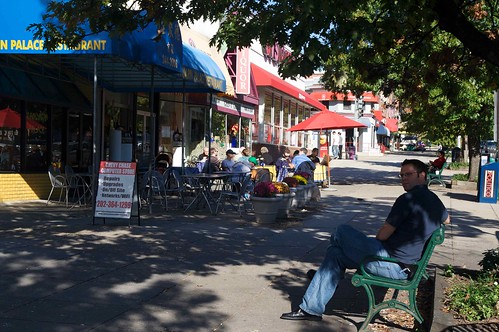Crossing the road vs. walking alongside the road and Connecticut Avenue NW

Photo by Ken Firestone of the Chevy Chase commercial district on upper Connecticut Avenue NW.
A couple weeks ago, the Examiner featured an interview with of Marlene Berlin of IONA Senior Services. She's working on a project called "Connecticut Avenue Pedestrian Action to improve walkability between Calvert Street and Western Avenue." See "The 3-Minute Interview: Marlene Berlin."
Also see "Battle Flag of the Pedestrians"from the Post, in 2005.
When you have to carry flags across the street, in order to protect yourself from being hit by a car, there is a "design" issue. In this case, it's one of an extremely wide street that does a great job carrying traffic into and out of the city, but that does a terrible job serving as a neighborhood street.
Crossing the street and reducing the conflicts between pedestrians and vehicles, ought to be a primary objective of pedestrian planning in that area. To be fair, that's what the Connecticut Avenue Pedestrian Action project is going to do. But to often, we are glibly describing problems without being hyper accurate.
In this case, the issue is crossing the road, the prevailing speed of traffic, the posted speed for vehicles, and the conflict of the road being a neighborhood avenue as well as a major in-bound and out-bound road with a large degree of regional traffic.
Note that this is one of the roads that I have been arguing for a couple years should be designated as an HOV-2 street (at least one of the lanes) during rush periods. Plus, it should be a priority to consider streetcar or light rail service on streets such as this in order to reduce the amount of regional traffic borne by the road.
From "D.C. cop pleads with pedestrians: Pay attention" from the Examiner:
In the wake of another pedestrian struck, a D.C. police officer has offered a fairly blunt assessment of the often dangerous behavior of those who share the road: Walkers and drivers simply don’t pay attention anymore. ...
She was the third pedestrian struck at the intersection in a year — the two previous victims died. Some vehicles do speed through that busy crossing, Baker said, but most average 34 to 37 mph. The speed limit there is 30 mph. As he surveyed the site with his radar gun, Baker said he watched pedestrian after pedestrian stroll by listening to their iPods and talking on their cell phones, crossing against the walk signal and stepping into the crosswalk in anticipation of a walk signal.
I raise this only because I am dealing with similar kinds of issues in Baltimore County, Maryland. There... I said it, that's where I am working, at least for the moment, as a bicycle and pedestrian planner, tasked with the development of a pedestrian and bicycling master plan for the urban section of the western part of Baltimore County. The finished plan will complement the Eastern Baltimore County Pedestrian and Bicycle Access Plan, and in combination will outline a conceptual on-street and off-street bicycle route network, along with significant improvements in the pedestrian environment for the entire urban section of the county.
(Baltimore County was one of the first jurisdictions in the U.S. to create an urban growth boundary, in 1967. Today, 90% of the County's populationo is located inside the Urban-Rural Demarcation Line.)
Anyway, in the context of what we're studying, we've created an online survey, which distinguishes between various types of issues (i.e., sidewalk conditions vs. crossing conditions, on-street bicycling vs. off-road multi-user trails, etc.
Labels: urban design/placemaking



0 Comments:
Post a Comment
<< Home